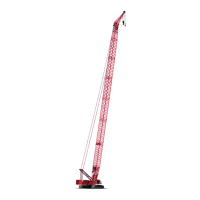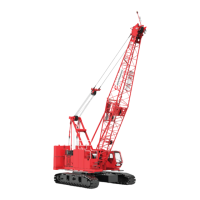POWER TRAIN 14000 SERVICE MANUAL
7-12
Published 09-05-14, Control # 226-02
EXHAUST AFTERTREATMENT SYSTEM
Figure 7-9 on page 7-13
The engine exhaust is treated to significantly reduce the
amount of harmful by-products of combustion from
contaminating breathable air.
Starting at the engine, the primary components of the
exhaust system are the:
• Diesel Oxidation Catalyst (DOC) module
• DRT Module with DEF dosing module
• Selective Catalytic Reduction (SCR) module
These are briefly described in the following paragraphs.
DOC Module
The primary function of the Diesel Oxidation Catalyst (DOC)
module (8) is to oxidize remaining hydrocarbons in the
exhaust to carbon dioxide. It incorporates a NO
x
(nitrogen
oxide) sensor, a dual pressure (dP) sensor, and two
temperature sensors.
There is no maintenance requirement for the DOC module.
DRT Module
Between the DOC and the SCR is the Decomposition
Reactor Tube (DRT) (6).
Mounted on the DRT is the DEF dosing module (7). The
dosing module injects a liquid mixture of urea and water
called Diesel Exhaust Fluid (DEF) into the exhaust stream
ahead of the SCR inlet. Coolant lines run through the dosing
module to keep it cool and operable.
There is no maintenance requirement for the DRT module.
SCR Module
The primary function of the Selective Catalytic Reduction
(SCR) module (9) is to reduce NO
x
content to nitrogen. The
DEF injected at the DRT module enters the SCR where the
urea and de-ionized water participate in a chemical reaction
which results in the desired content of the exhaust
emissions.
The SCR incorporates a catalyst, two temperature sensors,
an ammonia (NH
3
) sensor, and a NO
x
sensor.
There is no maintenance requirement for the SCR module.
Excessive NO
x
Warning System
If an excessive NO
x
warning is issued, check anything that
might cause an elevated NO
x
level, such as:
• Disconnect tank level or quality sensor
• Blocked DEF hose or dosing module
• Disconnected dosing module
• Disconnected supply module
• Disconnected SCR wiring harness
• Disconnected NO
x
sensor
• EGR valve malfunction
Aftertreatment Protection System
The Cummins Aftertreatment Protection System (APS)
continually monitors exhaust gas temperatures. In event of
excessive exhaust temperatures, the APS will illuminate the
High Exhaust System Temperature (HEST) lamp.
WARNING
Hot Exhaust Surfaces and Inhalation Hazards
Extremely hot surfaces and exhaust gasses
can cause death or serious injury. Allow engine
and exhaust system to cool before servicing.
CAUTION
Loss of Power or Engine Shutdown Hazard
If NO
x
emissions exceed legislated limits, the operator will
be alerted by warning lights and audible warnings. If the
condition is not corrected in a set amount of time, an
engine derate and shutdown sequence will begin.
For more information, refer to Section 3 of the 14000
Operator Manual.

